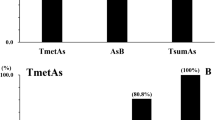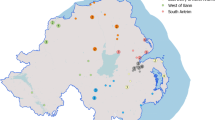Abstract
Objectives
The first aim of this study was to evaluate the association between time spent living near a contaminated area and concentration of arsenic (As) compounds in the urine among study subjects. The second aim is to assess the association between consumption of various foods or beverages and As concentration in urine among them.
Methods
Urine sampling was performed on 177 persons who voluntarily participated in the survey in May 2014. The median value of the sum of inorganic As (iAs) and total As (tAs) compounds was used for us to divide into two groups, such as the high and low iAs and high and low tAs groups. We analyzed data separately in two-age strata of age group A (the subjects <18 years old), and age group B (the subjects ≥18 years old). A multivariate analysis was performed with the logistic regression model to adjust for potential confounding variables.
Results
No link between time spent living near a contaminated area and urinary As concentration was observed in our study. For age group B, frequently drinking beer was significantly associated with risk of being in the high tAs group (p = 0.008). Compared to not drinking beer, odds ratios (95 % confidence intervals) of drinking beer <1 or 2 times per week, and drinking beer ≥3 or 4 times per week were 3.09 (1.32–7.24) and 3.00 (1.02–8.80), respectively, after adjusting for age, sex, and smoking index.
Conclusion
Frequent consumption of beer may be associated with high tAs in age group B
Similar content being viewed by others
References
Tchounwou PB, Patlolla AK, Centeno JA. Carcinogenic and systemic health effects associated with arsenic exposure- a critical review. Toxicol Pathol. 2003;31:575–8.
Tsuda T, Nagira T, Yamamoto M, Kume Y. An epidemiological study on cancer in certified arsenic poisoning patients in Toroku. Indust Health. 1990;28:53–62.
Nishikawa T, Wanibuchi H, Ogawa M, Kinoshita A, Morimura K, Hiroi T, Funae Y, Kishida H, Nakae D, Fukushima S. Promoting effects of monomethylarsonic acid, dimethylarsinic acid and trimethylarsine oxide on induction of rat liver preneoplastic glutathione S-transferase placental form foci: a possible reactive oxygen mechanism. Int J Cancer. 2002;100:136–9.
Sawada N, Iwasaki M, Inoue M, Takachi R, Sasazuki S, Yamaji T, Shimizu T, Tsugane S. Dietary arsenic intake and subsequent risk of cancer: the Japan Public Health Center-based (JPHC) Prospective Study. Cancer Causes Control. 2013;24:1403–15.
Navas-Acien A, Sharrett AR, Silbergeld EK, Schwartz BS, Nachman KE, Burke TA, Gualla E. Arsenic exposure and cardiovascular disease: a systematic review of the epidemiologic evidence. Am J Epidemiol. 2005;162:1037–49.
Hata A, Endo Y, Nakajima Y, Ikebe M, Ogawa M, Fujitani N. Endo G.HPLC-ICP-MS speciation analysis of arsenic in urine of Japanese subjects without occupational exposure. J Occup Health. 2007;49:217–23.
Yamauchi H, Takahashi K, Mashiko M, Saitoh J, Yamamura Y. Intake of different chemical species of dietary arsenic by the Japanese, and their blood and urinary arsenic levels. Appl Organometallic Chem. 1992;6:383–8.
Ishizaki M. Arsenic contents in food on the market and its average daily intake. Nihon Eiseigaku Zasshi. 1979;34:605–11 (Japanese text with English abstract).
Huang J-H, Hu K-N, Ilgen J, Ilgen G. Occurrence and stability of inorganic and organic arsenic species in wines, rice wines and beers from Central European market. Food Addit Contam. 2012;29:85–93.
Heitland P, Köster HD. Fast determination of arsenic species and total arsenic in urine by HPLC-ICP-MS: concentration ranges for unexposed German inhabitants and clinical case studies. J Anal Toxicol. 2008;32:308–14.
Brima EI, Haris PI, Jenkins RO, Polya DA, Gault AG, Harrington CF. Understanding arsenic metabolism through a comparative study of arsenic levels in the urine, hair and fingernails of healthy volunteers from three unexposed ethnic groups in the United Kingdom. Toxicol Appl Pharmacol. 2006;216:122–30.
Morton J, Mason H. Speciation of arsenic compounds in urine from occupationally unexposed and exposed persons in the U.K. using a routine LC-ICP-MS method. J Anal Toxicol. 2006;30:293–301.
Fillol C, Dor F, Clozel B, Goria S, Seta N. Does arsenic in soil contribute to arsenic urinary concentrations in a French population living in a naturally arsenic contaminated area? Sci Total Environ. 2010;408:6011–6.
Fillol C, Dor F, Labat L, Boltz P, Le Bouard J, Mantey K, Mannschott C, Puskarczyk E, Viller F, Momas I, Seta N. Urinary arsenic contaminations and speciation in residents living in an area with naturally contaminated soils. Sci Total Environ. 2010;408:1190–4.
Jensen GE, Christensen JM, Poulsen OM. Occupational and environmental exposure to arsenic—increased urinary arsenic level in children. Sci Total Environ. 1991;107:169–77.
Cottingham KL, Karimi R, Gruber JF, Zens MS, Folt CL, Punshon T, Morris JS, Karagas MR. Diet and toenail concentrations in a New Hampshire population with arsenic-containing water. Nutr J. 2013;12:149.
Lachenmeier DW, Przbylski MC, Rehm J. Comparative risk assessment of carcinogens in alcoholic beverages using the margin of exposure approach. Int J Cancer. 2012;131:E995–1003.
Herce-Pagliai C, González G, Camean M, Repetto M. Presence and distribution of arsenical species in beer. Food Addit Contam. 1999;16:267–71.
Cervera ML, Navarro A, Montoro R, Catala R, Ybañez N. Determination of arsenic in beer by dry ashing, hydride generation atomic absorption spectroscopy. J Accoc Off Anal Chem. 1989;72:282–5.
Anonymous. FDA data show arsenic in rice, juice, and beer. Consumer Rep 2014:79(3):14–15.
Oguri T, Yoshinaga J, Tao H, Nakazato T. Inorganic arsenic in the Japanese diet: daily intake and source. Arch Environ Contam Toxicol. 2014;66:100–12.
Rahman MA, Rahman MM, Reichman SM, Lim RP, Naidu R. Arsenic speciation in Australian-grown and imported rice on sale in Australia: implications for human health risk. J Agric Food Chem. 2014;62:6016–24.
Rintala E-M, Ekholm P, Kovivisto P, Peltonen K, Venäläinen E-R. The intake of inorganic arsenic from long grain rice and rice-based baby food in Finland—low safety margin warrants follow up. Food Chem. 2014;150:199–205.
Davis MA, Mackenzie TA, Cottingham KL, Gilbert-Diamond D, Punshon T, Karagas MR. Rice consumption and urinary arsenic concentrations in U.S. children. Environ Health Perspect. 2012;120:1418–24.
Gilbert-Diamond D, Cottingham KL, Gruber JF, Punshon T, Sayarath V, Gandolfi AJ, Baker ER, Jackson BP, Folt CL, Karagas MR. Rice consumption contributes to arsenic exposure in U.S. women. Proc Natl Acad Sci USA. 2011;108:20656–60.
Fontcuberta M, Calderon J, Villabi JR, Centrich F, Portaňa S, Espelt A, Duran J, Nebot M. Total and inorganic arsenic in marketed food associated health risks for the Catalan (Spain) population. J Agric Food Chem. 2011;59:10013–22.
Ling M-P, Wu C-H, Chen S-C, Chen W-Y, Chio C-P, Cheng Y-H, Liao C-M. Probabilistic framework for assessing the arsenic exposure risk from cooked fish consumption. Environ Geochem Health. 2014;36:1115–28.
Choi B-S, Choi S-J, Kim D-W, Huang M, Kim N-Y, Park K-S, Kim C-Y, Lee H-M, Yum Y-N, Han E-S, Kang T-S, Yu I-J, Park J-D. Effects of repeated seafood consumption on urinary excretion of arsenic species by volunteers. Arch Environ Contam Toxicol. 2010;58:222–9.
Vahter M, Lind B. Concentrations of arsenic in urine of the general population in Sweden. Sci Total Environ. 1986;54:1–12.
Cleland B, Tsuchiya A, Kalman DA, Dills R, Burbacher TM, White JW, Faustman EM, Mariën K. Arsenic exposure within the Korean Community (United States) based on dietary behavior and arsenic levels in hair, urine, air, and water. Environ Health Perspect. 2009;117:632–8.
Acknowledgments
The authors thank Dr. Shuji Dohi, MD & PhD, General Administrator of Muroran City General Hospital. Without his help, this research could not be executed.
Author information
Authors and Affiliations
Corresponding author
Ethics declarations
Conflict of interest
No conflict of interest was declared by any author.
Rights and permissions
About this article
Cite this article
Mori, M., Sato, T., Yoshida, H. et al. Association of beer consumption with arsenic concentration in urine: a result from a cross-sectional study of the general Japanese population. Environ Health Prev Med 21, 327–333 (2016). https://doi.org/10.1007/s12199-016-0533-3
Received:
Accepted:
Published:
Issue Date:
DOI: https://doi.org/10.1007/s12199-016-0533-3




